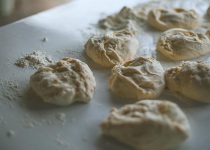How to Assemble a Cup Turner With Rotisserie and Pvc Pipe
Ever wondered if you could create your own cup turner using a rotisserie motor and PVC pipe? Assembling a cup turner with these materials may seem daunting, but it's a rewarding project that's within your reach. With the right guidance, you can master the process and craft a functional cup turner for your epoxy resin crafts.
This guide will walk you through the steps, from gathering the necessary materials and tools to wiring the motor and installing the cup holding mechanism. By the end, you'll have a fully assembled cup turner ready to bring your crafting projects to life.
Let's dive in and bring your cup turner to fruition!
Key Takeaways
- Proper maintenance and inspection of the rotisserie motor is essential before assembling the cup turner.
- Accurate measurements and stable assembly of the PVC pipe frame are crucial for the cup turner's stability and proper functioning.
- Secure wiring of the rotisserie motor, including proper identification of positive and negative wires, is necessary for safe and efficient operation.
- Following safety measures, such as checking electrical connections, using non-toxic paint, and operating in a well-ventilated area, ensures the longevity of the cup turner and prevents accidents or injuries.
Required Materials and Tools
To assemble a cup turner with rotisserie and PVC pipe, you'll need specific materials and tools.
For the motor installation and electrical wiring, you'll require a small electric motor, an on/off switch, electrical wires, and wire connectors. Additionally, have a power adapter, a female DC power jack, and a speed controller.
When it comes to pipe cutting and assembly techniques, gather PVC pipes, 90-degree elbow joints, T-shaped joints, PVC pipe cutter, PVC cement, and measuring tape.
The tools needed include a drill with bits, screwdriver, wire stripper, wire cutter, soldering iron, and a hot glue gun for securing wires.
It's essential to have a ruler, pencil, and a sturdy work surface to ensure accurate measurements and a stable assembly process.
As you gather these materials and tools, ensure they're of good quality to guarantee the safety and efficiency of your cup turner.
With these items at hand, you're now ready to proceed with the construction of your cup turner with rotisserie and PVC pipe.
Preparing the Rotisserie Motor
Prepare the rotisserie motor by ensuring it's securely mounted to the PVC pipe.
Before you start assembling the cup turner, it's crucial to check the rotisserie motor for any maintenance needs. Inspect the motor for any signs of wear and tear, and consider troubleshooting any issues before proceeding.
Make sure the motor is clean and free of any debris that could affect its performance.
Additionally, if you're considering custom attachment options or modifications, now is the time to plan for them. Whether you need to adapt the motor to fit the PVC pipe or create a specific attachment for your cup turner, taking the time to prepare the motor for these customizations will save you a lot of hassle later on.
Building the PVC Pipe Frame
Now, carefully measure and cut the PVC pipes to the required lengths using a saw or PVC pipe cutter. It's essential to ensure accurate pipe measurements to guarantee stability and proper assembly of the cup turner. Here's a table to guide you through the pipe measurements:
| PVC Pipe | Length (in inches) |
|---|---|
| Bottom | 18 |
| Uprights | 12 |
| Top | 18 |
Wiring the Rotisserie Motor
After assembling the PVC pipe frame for your cup turner, you'll need to wire the rotisserie motor to ensure proper functionality. Start by identifying the positive and negative wires on the rotisserie motor. Connect the positive wire from the motor to the positive terminal of the power source, and the negative wire to the negative terminal. You can use a soldering iron and solder to create secure connections.
Once the wiring connections are secure, it's important to test the motor to ensure it's rotating in the correct direction. If the rotation isn't as desired, simply swap the connections to the power source.
Additionally, consider incorporating a motor speed control switch into the wiring to adjust the rotation speed of the cup turner. This will allow you to customize the speed based on the specific requirements of your crafting projects.
Once the wiring is complete and the motor is functioning as intended, you can proceed with confidence to the next steps of assembling your cup turner.
Installing the Cup Holding Mechanism
You will attach the cup holding mechanism to the PVC pipe frame using screws and a power drill. This will ensure that the cups are securely held in place during the turning process. Here's a simple guide to help you understand the cup holder attachment process:
| Step | Instructions | Tools Needed |
|---|---|---|
| Step 1 | Place the cup holder mechanism on the PVC pipe frame, ensuring it is centered and level. | – |
| Step 2 | Use a power drill to make pilot holes through the pre-drilled holes in the cup holder mechanism and into the PVC pipe. | Power drill, drill bits |
| Step 3 | Secure the cup holder mechanism to the PVC pipe frame using screws. Ensure they are tightened to hold the cup holder firmly in place. | Screws, screwdriver |
By following these steps, you can ensure that the cup holding mechanism is securely attached to the PVC pipe frame, allowing you to create beautiful designs on your cups without any worries.
In addition, once the cup holder is attached, you can explore various painting techniques and creative cup designs to use with your cup turner. This will not only enhance your creations but also add a personal touch to your work. Remember to perform regular cup turner maintenance to ensure its longevity and efficiency.
Testing and Troubleshooting
Now that your cup turner is assembled, it's time to test and troubleshoot.
You'll want to make sure the rotisserie motor speed is balanced and that the wiring connections are identified and secure. These points are crucial to ensure your cup turner works smoothly and effectively.
Balancing Rotisserie Motor Speed
To ensure the rotisserie motor speed is balanced, regularly monitor and adjust the RPM using a tachometer. Start by checking the motor speed control and ensure it's set to the appropriate level for your cup turner.
If you notice any imbalance, try balancing techniques like adding small weights to the motor shaft.
Additionally, keep the rotisserie motor well-maintained by regularly checking for any signs of wear or damage. Troubleshooting tips include inspecting the motor's connections and ensuring they're secure.
If you encounter speed fluctuations, consider cleaning the motor and lubricating its moving parts.
Identifying Wiring Connection Issues
Regularly monitor the wiring connections of your cup turner's rotisserie motor to identify any potential issues related to testing and troubleshooting. Proper electrical connections are crucial for the smooth operation of the cup turner. When troubleshooting wiring connection issues, it's important to use the right techniques to ensure that the motor functions optimally. Here are some key troubleshooting techniques to help you identify and rectify wiring connection issues:
| Issue | Troubleshooting Technique |
|---|---|
| Loose connections | Check and tighten all wire connections to ensure a secure fit. |
| Frayed wires | Inspect wires for any signs of fraying or damage and replace if necessary. |
| Voltage irregularities | Use a multimeter to test for consistent voltage flow through the connections. |
Finishing Touches and Safety Precautions
After assembling your cup turner with rotisserie and PVC pipe, it's important to regularly inspect all connections and moving parts for signs of wear or damage. Safety measures are crucial to ensure the proper functioning of your cup turner. Check the electrical connections, making sure they're secure and free from any fraying or exposed wires. This will help prevent any potential electrical hazards.
When it comes to painting and finishing touches, make sure to use non-toxic, heat-resistant paint. This won't only give your cup turner a polished look but also ensure that the paint won't emit any harmful fumes when the rotisserie is in operation. Additionally, consider adding a protective coating to the PVC pipe to safeguard it against the wear and tear of regular use. This simple step can prolong the life of your cup turner and keep it looking new.
Always remember to operate your cup turner in a well-ventilated area to prevent the buildup of fumes from the paint or any potential overheating. By following these safety precautions and finishing touches, you can enjoy using your cup turner with peace of mind.
Frequently Asked Questions
How Do I Ensure That My Cup Turner Is Properly Balanced and Not Wobbly When in Use?
To ensure your cup turner is stable and not wobbly during rotation, make sure the PVC pipe is securely attached to the rotisserie and evenly balanced. Check for any loose connections and adjust as needed for proper balance.
Can I Use a Different Type of Motor Other Than a Rotisserie Motor for This Project?
Yes, you can use different motors for the cup turner. Consider the motor's compatibility with the project and DIY modifications. Look for alternative supplies and ensure the new motor meets the required specifications for stability and rotation.
What Are Some Common Safety Precautions to Keep in Mind When Using a Cup Turner?
When using a cup turner, always prioritize safety measures. Regularly maintain equipment to prevent hazards. Assess risks and take necessary precautions. Inspect wires, connections, and moving parts for any potential issues that could cause harm.
Can I Customize the Size and Shape of the PVC Pipe Frame to Fit My Specific Needs?
Yes, you can absolutely customize the size and shape of the PVC pipe frame to fit your specific needs. There are various PVC pipe alternatives available, allowing you to tailor the frame to your preferences.
Are There Any Potential Issues or Troubleshooting Tips to Be Aware of When Wiring the Rotisserie Motor for the Cup Turner?
When wiring the rotisserie motor for the cup turner, watch out for potential wiring issues like loose connections or incorrect voltage. Consider motor alternatives if the current one isn't working. Double-check your setup for a smooth operation.



